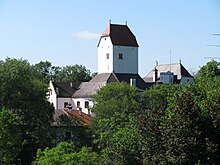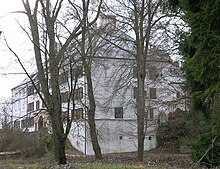Basselet of La Rosée (noble family)
The Counts Basselet von La Rosée are a very old, originally Spanish, noble family who immigrated to Bavaria from the former Spanish Netherlands and were raised to the rank of count in 1764.
history
The Basselet von La Rosée family descends from the noble family of the Margraves de la Rosa, which originally flourished in Spain and later in what was then the Spanish Netherlands . Gomard Basselet de la Rosée (1649–1709) and Marie Therese de Septfontaine (1683–1755) had three sons: the brothers Theodor, Franz Servaz and Johann Caspar, who entered the military service of the Bavarian Elector Max Emanuel , came to Bavaria with him and were henceforth linked to the history of the Bavarian army. Subsequently they called themselves Basselet de la Rosée and were the founders of this branch of the family, which was raised to the rank of count in 1764. The family branched out in Bavaria and Austria and is still blooming in various branches today.
Personalities
- Jean Gaspard (Johann Caspar) de La Rosée (1710–1795), he rose to the position of Real Privy Councilor , field marshal lieutenant and head of a cavalry regiment, and finally became president of the court war in Munich. As the commander of Munich, the same Emperor Franz I was sent to Straubing and received from him on April 5, 1764, orally, and later by diploma, the status of imperial count. Around 1762 he acquired what was then Hofmark Wörth together with the Hofmarks Feldafing , Possenhofen and the Roseninsel and thus owned the largest closed shore area on Lake Starnberg , then Würmsee. He was first with Maria Elisabetha Freiin von Ruffini (born April 14, 1718 in Munich; † November 2, 1764 in Feldafing) and then with Josepha Freiin von Nauendorf (born August 4, 1739 in Geilsdorf; † April 2, 1799 in Munich) married. From this second marriage came Maximilian (* March 28, 1768, † January 13, 1797), royal Bavarian treasurer and president of the forest chamber, married to Antonie Comtesse von Oberndorf, who died without heirs.
- Joseph Adolph Imperial Count Basselet von La Rosée (* October 7, 1773 - January 17, 1834), the younger son of this second connection, married Elisabeth Comtesse von Rechberg and Rothenlöwen zu Hohen on August 4, 1797 (* September 24, 1772; † June 16, 1848) and had two sons with her, Maximilian Emanuel Placidus (* October 5, 1799 - July 2, 1869) and Theodor Raphael (see below).
- Johann Caspar Aloys Count Basselet von La Rosée (1747–1826), from his first marriage, was a royal Bavarian chamberlain , real secret councilor, councilor of state in extraordinary service and president of the court of appeal . He was married to Maria Theresia Franziska Comtesse Topor von Morawitzki (born December 10, 1751 in Amberg , † May 29, 1833 in Munich). The Reichsfreiin von Kappleri sold Eisendorf to Johann Kaspar Aloys in 1805 as a widow. He now called himself Geretshausen , Possenhofen , Hirschbichl , Elkofen , Eisendorf and Grafing . Possenhofen and the two court brands as well as the castle finally came into the possession of Duke Maximilian Joseph in Bavaria in 1834 . His daughter Elisabeth (Sisi) , who later became the wife of Emperor Franz Joseph I, spent her youth here .
- Franz Xaver Basselet Count von la Rosée (born August 21, 1774 in Munich , † January 8, 1829 in Neuburg an der Donau ), son of the royal Bavarian chamberlain and colonel described above, continued the family. With Clara Freiin von Murach auf Firsing, (born September 19, 1775 in Ehrenbreitstein ; † February 6, 1858 in Munich) he fathered Heinrich Raphael (see below) and Maximilian Heinrich (1804–1868). After the death of Elector Karl Theodor, the so-called “Herrenfall” had occurred; The fiefdom holder had to endeavor to have the main and active fiefs recognized by Max IV Joseph on December 31, 1799, based on the fief book specified in 1729. In 1813 the possessions were bought by the Counts Basselet de la Rosée, who stayed mainly in the royal seat. The leasable Hofmark was allodified in 1820 and leased by the La Rosee.
- Heinrich Joseph Raphael Basselet Count von la Rosée (born April 16, 1803 in Munich; † July 27, 1869 there), the grandson of Count Johann Caspar Aloys and son of Count Franz Xaver, was the lord of Hof- und Grüngiebing , royal vassal of Ritterlehens Armstorf , Royal Bavarian Chamberlain, Knight of the Order (December 18, 1834), then Grand Cross (June 26, 1835) of the Royal Bavarian House Knight Order of St. Michael , married on March 12, 1833 to Franziska Johanna von Schneidheim, from which marriage two sons emerged.
- Maximilian Emanuel Placidus Count Basselet von La Rosée (born October 3, 1799), son of Count Joseph Adolph, the stepbrother of Count Johann Caspar Aloys, was the royal Bavarian treasurer and lord of the manor of Inkhofen and Dornhafelbach in Upper Bavaria. By virtue of the highest resolution of King Ludwig I of June 28, 1830 in Munich, he was appointed royal chamberlain and married Hyacintha Elisabeth Freiin von Gumppenberg-Pöttmes-Brennberg on November 26, 1832 (born August 29, 1808).
- Theodor Raphael Aloys Reichsgraf Basselet von La Rosée (born November 9, 1801 in Munich; † April 15, 1864 ibid), son of Count Joseph Adolph Basselet von La Rosée, was royal Bavarian major general and adjutant to King Maximilian I Joseph of Bavaria . From May 1854, the count had been tutor to the two princes Ludwig and Otto. He married Freiin Ludovika von Leuprechting on November 26, 1826 (+ April 15, 1864 in Munich).
- August Desiderius Count Basselet de la Rosée (1898–1970), President of the Bavarian Homeland and Royal Association
- Maria Hedwig Juliane Countess de la Rosée, georende Maria Hedwig Juliane Countess von Moy de Sons (* July 30, 1893, † July 21, 1975)
coat of arms
1764: Squared shield with central shield. In the red central shield an upright white rose with a green stem and two green leaves. 1 and 4 in silver a rectangular carbuncle stone divided by red and black obliquely to the left with eight flowered red rays in the form of a common and a St. Andrew's cross. 2 and 3, two blue, undulating oblique bars in gold. There are three crowned helmets above the count's crown. The right helmet wears a tall, silver, red hat, which is covered in the middle with the radiant carbuncle stone of the 1st and 4th field and the golden button is studded with three ostrich feathers, silver, red, blue; the middle one a closed eagle flight facing the Saxons to the right, the right wing of which is silver, the left one red, and the left helmet a golden standard, the golden flag of which is covered with the wavy blue, oblique left bars of the 2nd and 3rd field. The helmet covers are red and silver on the right and blue and gold on the left, and the shield is held by two forward-facing lynxes with curved tails.
or:
1764: The shield, squared of silver and gold, has a red central shield, and in it an upright white rose with a green stem and two green leaves. In the first and fourth silver field a square carbuncle stone divided by red and black obliquely to the left, with eight flowered red rays in the form of a common and St. Andrew's cross. (These figures placed in the cross are indicated as red rays in the Count's letter of 1764, but here they appear to be similar to goblets; in Siebmacher's large book of arms, Tab. 1, they are clover angels, the leaves of the rose in the center shield are white, and the The flagstick on the third helmet is silver.) In the second and third golden fields, two blue, undulating left sloping bars. The shield is covered by the count's crown, and on it are five open, crowned tournament helmets. The first carries a closed flight, facing the Saxons to the right, the right wing of which is made of silver, but the left wing is red; The second a tall, silver, red pagan (tournament) hat, the golden button of which is studded with 5 ostrich feathers, the middle of which is red, the right golden and the left blue, and in the middle of which the carbuncle stone with the 8 rays is repeated; and on the red helmet is a golden standard, on the golden flag of which the two undulating blue left sloping bars of the second and fifth fields appear again. Helmet covers on the right: red and silver, on the left: blue and gold. Shield holder: Two silver lynxes with curved tails.
literature
- Gothaisches Genealogical Pocket Book of the Count's Houses B III. Volume 35, Verlag CA Starke, Limburg ad Lahn 1965.
Web links
Individual evidence
- ^ Karl Staudinger: The Royal Bavarian 2nd Infantry Regiment "Kronprinz" 1682 to 1882. Verlag R. Oldenbourg, Munich 1882, p. 119.
- ↑ a b Johann Baptist Kranzmayr: Coat of Arms Almanac of the Royal Bavarian House Knight Order of Saint Michael. Munich 1886, p. 105.
- ^ Karl Heinrich Ritter von Lang: Book of the nobility of the Kingdom of Baiern: Basic work. Volume 1, Reichsheroldsamt, Munich 1815, p. 42.
- ↑ Gottfried Mayr: Ebersberg, Court of Swabia. (= Historical Atlas of Bavaria. Part of Old Bavaria. Volume 48). Publishing Commission for Bavarian State History, Munich 1989, ISBN 3-7696-9913-0 , p. 318.
- ↑ http://www.verwandten.info/wt2/family.php?famid=F23275&ged=adel.GED ( Memento from June 26, 2013 in the web archive archive.today )
- ↑ Stephan M. Janker: Historical Atlas of Bavaria: Part of Old Bavaria. Publishing Commission for Bavarian State History, Munich 1996, p. 280.
- ↑ genealogie-oberbayern.de
- ↑ Gottfried Ritter von Böhm: Ludwig II. King of Bavaria, his life and his time. Verlag HR Engelmann, Berlin 1922, p. 5.
- ^ Eduard Maria Oettinger, Hugo Schramm-Macdonald: Moniteur des dates: Contenant un million de renseignements biographiques, généalogiques et historiques. Volume 1, Verlag Ludwig Denicke, Leipzig 1869, p. 62.
- ↑ a b Ernst Heinrich Kneschke: German count houses of the present: in heraldic, historical and genealogical relation. 2nd volume: LZ. Verlag TO Weigel, Leipzig 1853, p. 11f.
- ^ August D. Count Basselet de la Rosée , In: Internationales Biographisches Archiv. 10/1952 from February 25, 1952, in the Munzinger archive ( beginning of article freely available)
- ↑ Maria Hedwig Juliane Countess de la Rosée, in: Critical online edition of the diaries of Michael Cardinal von Faulhaber (1911-1952). Available at https://faulhaber-edition.de/suche-kurzbiographien-html?idno?=00505 }
- ↑ Martin Carl Wilhelm von Wölckern on Kalchreuth: Descriptions of all coats of arms of the princely, counts, baronial and aristocratic families now living in the Kingdom of Bavaria. Volume 1, Nuremberg 1821, p. 138, no. 66.





